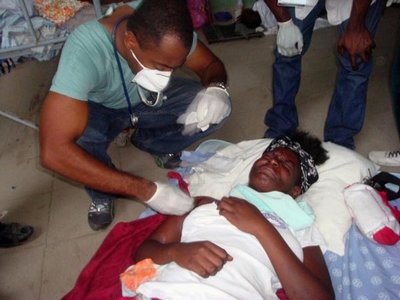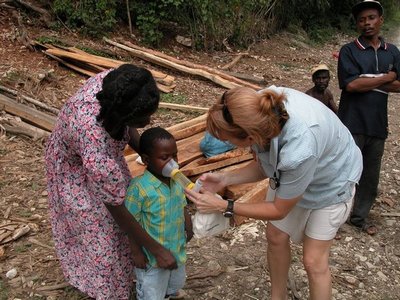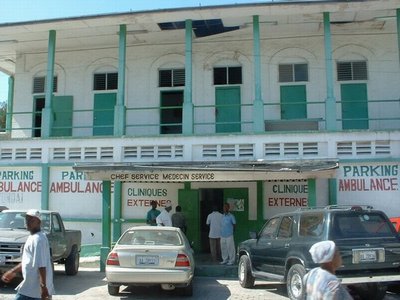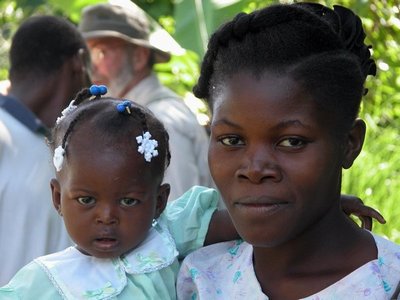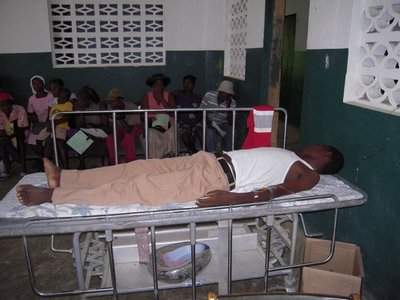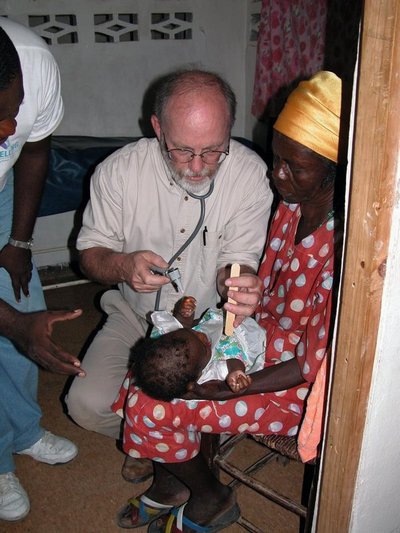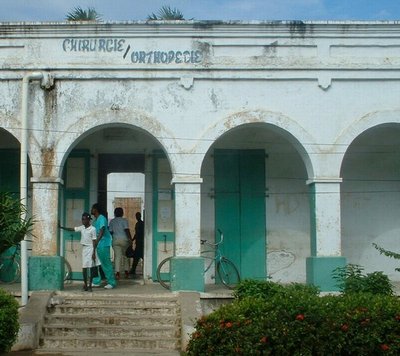January 21, 2010
UW perspective on the Haitian earthquake disaster: seismology, damage and volunteer medical response
THE EARTHQUAKE: On Tuesday, Jan. 12, a magnitude 7 earthquake struck Haiti at 1:53:10 p.m. PST along the Enriquillo-Plantain Garden fault, which U.S. Geological Survey geophysicist Tom Yelin describes as geologically similar to the San Andreas in California. Yelin said an almost horizontal movement occurred on the strike slip fault. The epicenter was 10 miles west of the Haiti capital, Port-au-Prince. People felt severe shaking for 35 seconds. Thirty-two aftershocks were located in the first eleven hours.
Within eight to nine minutes of the quake, Yelin said, recording stations for the Pacific Northwest Seismic Network at the UW Department of Earth and Space Sciences picked up propagated waves reaching our area through the Earth’s mantle.
THE DAMAGE: Based on the size and location of the earthquake, the U.S. Geological Survey estimated that about 3 million people were in the severe shake area. The shallow depth (eight miles below the surface) and close distance to a large city contributed to massive destruction.
“Haiti is hilly and mountainous. Steep terrain is subject to earthquake-induced landslides that can block roads,” Yelin noted.
Many of Haiti’s buildings were not constructed to earthquake-resistant standards and could not withstand side-to-side motion. Structures fell and pavement buckled from the proximity, power and duration of shaking. The extent of damage and number of casualties is still not known. Managing the aftermath is further hampered by the loss of the palace and other government buildings. Many hospitals and health care centers were damaged. Some have been vacated. The devastation to a small country as populated and as poor as Haiti is beyond comprehension.
THE UW HUMANITARIAN MEDICAL RESPONSE: In the aftermath of the earthquake, a number of UW Medicine and UW Health Sciences faculty, students and health professionals are preparing to go to Haiti in the next few weeks to treat the sick and injured and care for the displaced. They will volunteer with a variety of disaster response agencies and with groups that have been helping with health care in Haiti for many years. The earthquake fractured the fragile health-care system in the developing nation, which has been trying to emerge from decades of political instability, brutality and corruption.
Several UW Medicine physicians are responding to a request from the U.S. Department of Health and Human Services to medical schools and teaching hospitals in the United States. Dr. Nicole Lurie, the U.S. Assistant Secretary for Preparedness and Response, has specifically asked for trauma surgeons, orthopaedists, anesthesiologists and others with expertise in treating crush injuries and a willingness to work under austere conditions.
When rubble is suddenly lifted off a person trapped under heavy debris, blood overloaded with calcium and potassium leaked from destroyed cells, rushes back into compressed arms or legs. This crush syndrome can set off a heart attack, abnormally low blood pressure or other circulatory problem. Toxins from muscle breakdown can cause kidney failure.
Several UW physician experts in spine trauma, pediatric trauma, general trauma and trauma anesthesiology have volunteered for federal service. Those requesting placement so far include Dr. David Barei, Dr. Carlo Bellabarba, Dr. Rick Bransford, Dr. Jens Chapman, Dr. Bob Dunbar, and Dr. Chris Wahl, all from the UW Department of Orthopaedic Surgery. Bellabarba is also with the UW Department of Neurological Surgery. As important as their volunteering in the disaster zone is their UW Medicine colleagues temporarily assuming their responsibilities at the UW. In addition, several of their stateside UW Medicine and other UW colleagues are raising funds for the disaster response and recovery and for Haitian health professionals affected by the quake. Among them are global infectious disease expert Dr. Ann Marie Kimball, professor of epidemiology and health services, who offered to match her students’ donations to relief agencies. A dozen students responded. More than $2,000 was given to Partners in Health, Medicins Sans Frontiers, International Red Cross, Meds and Food for Children, and Mercy Corps.
The International Training and Education for Health (I-TECH), one of the centers within the UW Department of Global Health, has 36 employees in Haiti. All are accounted for. The I-TECH staff has set up a relief fund for their Haitian colleagues.
Harborview Medical Center is one of three lead institutions in the United States for the International Medical Surgical Response Team (IMSuRT). The team has surgeons, nurses, pharmacists, respiratory therapists, clinical engineers and other staff trained in triage and on-site care. They are issued special passports and can be deployed within 16 hours anywhere in the world.
One of the IMSuRT volunteers quickly dispatched to Haiti from UW Medicine is orthopaedic trauma and spine surgeon Dr. Jim Kreig. He is operating out of the Port-au-Prince soccer stadium. Dr. Brad Henley, a UW Medicine trauma expert on the IMSuRT team, is awaiting possible deployment to Haiti. At this writing, Carolyn Blayney, nurse manager of Harborview Medical Center’s Burn Intensive Care Unit and Pediatric Intensive Care Unit, is in Atlanta readying for a medical mission flight to Haiti.
Director of UW Medical Center Emergency Services Dr. Kathleen Jobe has volunteered in Haiti every year for the past decade to provide food, medical supplies and health care in the town of Leon. For many months she has planned to return to Haiti in February. She is still going, but what she will be doing will be different. Jobe will likely receive word soon for specific plans from the Seattle/King County Disaster Team to volunteer where she is most needed. The Seattle/King County Disaster Team is a private non-profit. All donations go directly to patient care and nutrition. Today, Thursday, Jan. 21, Pho Saigon (1016 Madison St.) on First Hill is donating its entire day’s proceeds and gratuities to the Seattle/King County Disaster Team.
“We will provide whatever medical care we can to meet the needs of the Haitian people,” Jobe said. The hardest part, she said, is waiting to hear if the Haiti staff she has worked with and the adults and children she has cared for in the past are OK.
Her UWMC emergency department colleague, Dr. Elizabeth Dorn, will leave for Haiti with Global Health Ministries, made up of adult and pediatric emergency physicians, nurses and other emergency-care personnel. Dorn has special expertise in crosscultural sensitivity and communications in emergency services.
When Jobe arrives in Haiti, shortages of clean water and food will be major issues for her patients. Dehydration will be a common medical problem. Unsanitary conditions may promote outbreaks of gastrointestinal illnesses. She also expects to treat the metabolic effects of crush syndrome. Emotional upheaval, shock and grief will be widespread. She said that many of her patients would likely have lost at least one close relative. She has heard that city residents originally from rural villages are trying to leave Port-au-Prince in the hopes of going home and restoring their previous lives.
Jobe is no stranger to overwhelming disasters and organizing medical care in unimaginable circumstances. She treated evacuees from Hurricane Katrina in the makeshift clinical setting of the Louis Armstrong New Orleans Airport. The emergency care team made do with what was available. Baggage carts, for example, transported patients, lying three or four across, from helicopters to treatment areas. She and her colleagues later wrote in Travel Medicine and Infectious Diseases about the lessons they learned, such as the necessity of utilizing the Incident Command System to coordinate an otherwise haphazard medical response.
In addition to the individuals and medical response programs mentioned, many other UW faculty, staff and students will be assisting in Haiti in the next few months during the immediate response, and for years ahead as the struggling nation attempts to recover from the 2010 earthquake.
